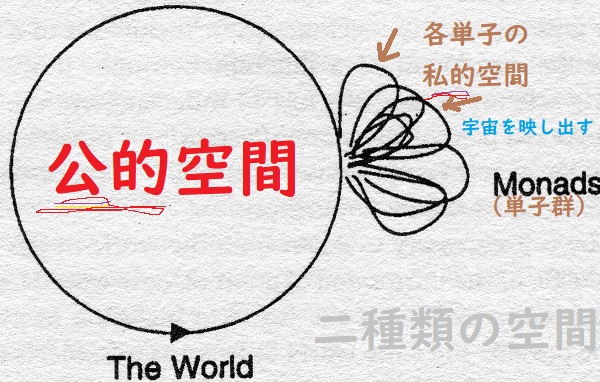(私自身の見解を)ライプニッツの見解と比較することによって、多分,私の見解を最も明確にできるだろうと思う。ライプニッツは,宇宙は(多数の)単子(モナド)から成っており、各単子のいずれも一つの小さな精神であって、それぞれの単子はこの宇宙を映し出している、と考えた。各単子は様々な程度の不正確さで宇宙を映す。最上の単子(注:複数)は(単子が映す)宇宙像において混乱が最も少ない。ライプニッツは、アリストテレスの主語述語論理(学)によって誤り導かれ、単子は相互に作用し合わないとともに、単子が同一の宇宙を映し続けるという事実は予定調和(pre-established harmony)によって説明されるべきである、と考えた。彼の学説のこの部分は全く受けいれられない。我々がこの世界を映す限りにおいて(in so far as),我々がこの世界を映すのは,外界(外部世界)が我々に及ぼす因果作用(causal action)を通してのみである(可能である)(訳注:”action”は人間の場合は「行為」だが,物が働く場合は「作用」)。しかし,彼の学説には別のいくつかの側面があり、それは私が擁護したい理論(説)とより一致している。それらの側面のなかで最も重要なもののひとつは空間に関するものである。ライプニッツにとって空間には2種類あった。(ただし,この点について、彼は決して明確ではなかった。)(即ち)各単子の持つ私的世界における空間があり、それは(それぞれの単子に与えられる)所与(与件/データ)以上の何ものをも仮定(想定)することなしに、それらの所与(与件)を分析し配列することによって知ることができる(ところの)空間である。しかし,またもうひとつの種類の空間も存在する(とライプニッツは考える)。ライプニッツは,各単子は各自の観点(視点)から世界を映しており,観点の相違は視野の相違に相似している,と言う。多くの観点を集めたものを整理したもの(arrangement)は,我々に各単子の私的世界における空間とは異なるもうびとつの種類の空間を与える。この公的空間(public space 公共空間)において、各単子は一つの点、あるいは,ともかくも,非常に小さな領域を占める。私的世界にも私的空間があってそれはその私的な観点(視点)から見ると無限であるけれども、この(私的には)無限な(空間の)全体は、その単子が他の多くの単子の間に置かれる時にはとても小さな一点に収縮する。我々は各単子の所与(与件)の世界における空間を「私的」空間と呼び、多種多様な単子の多種多様な観点の集まりからなる空間を「物理的」空間と呼んでもよいだろう。(各)単子が世界を正しく映すかぎり、「私的」空間の幾何学的諸特性は、物理的空間の幾何学的諸特性と相似するであろう。
Chapter 2: My present view of the world, n.10
I think perhaps I can best make my own views clear by comparing them with those of Leibniz. Leibniz thought that the universe consisted of monads, each of which was a little mind and each of which mirrored the universe. They did this mirroring with varying degrees of inexactness. The best monads had the least confusion in their picture of the universe. Misled by the Aristotelian subject-predicate logic, Leibniz held that monads do not interact, and that the fact of their continuing to mirror the same universe is to be explained by a preestablished harmony. This part of his doctrine is totally unacceptable. It is only through the causal action of the outer world upon us that we reflect the world in so far as we do reflect it. But there are other aspects of his doctrine which are more in agreement with the theory that I wish to advocate. One of the most important of these is as to space. There are for Leibniz (though he was never quite clear on this point) two kinds of space. There is the space in the private world of each monad, which is the space that the monad can come to know by analysing and arranging data without assuming anything beyond data. But there is also another kind of space. The monads, Leibniz tells us, reflect the world each from its own point of view, the differences of points of view being analogous to differences of perspective. The arrangement of the whole assemblage of points of view gives us another kind of space, different from that in the private world of each monad. In this public space, each monad occupies a point or, at any rate, a very small region. Although in its private world there is a private space which from its private point of view is immense, the whole of this immensity shrinks into a tiny pin-point when the monad is placed among other monads. We may call the space in each monad’s world of data ‘private’ space, and the space consisting of the diverse points of view of diverse monads ‘physical’ space. In so far as monads correctly mirror the world, the geometrical properties of private space will be analogous to those of physical space.
Source: My Philosophical Development, chap. 2,1959.
More info.:https://russell-j.com/beginner/BR_MPD_02-100.HTM

